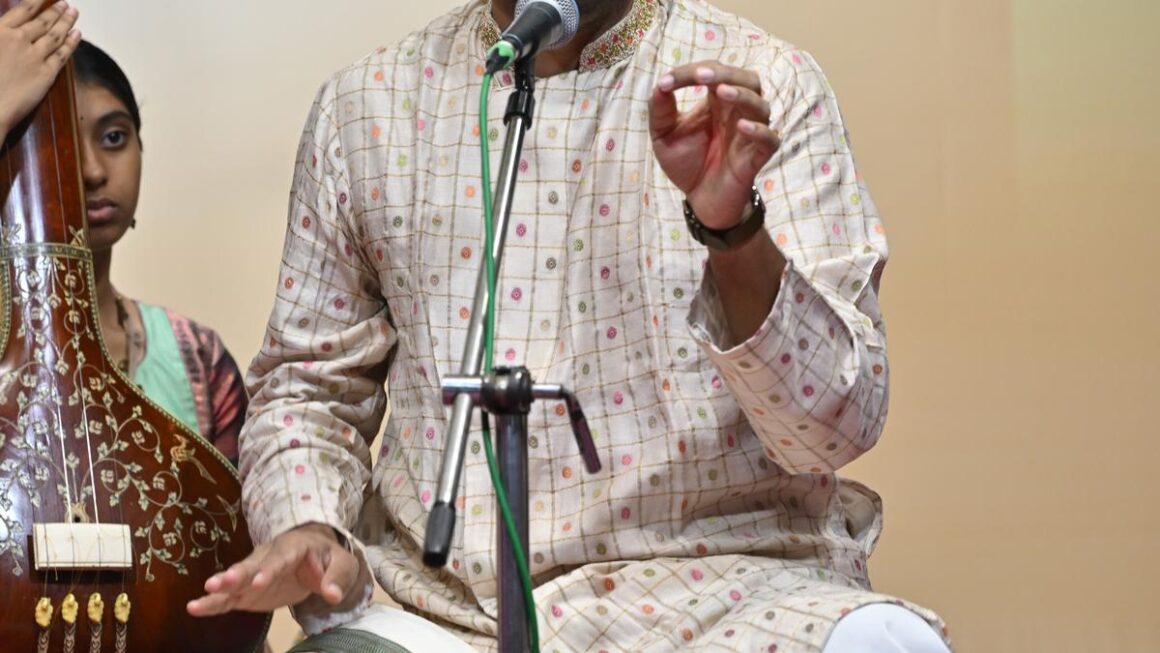
Rithvik Raja
| Photo Credit: M. Srinath
A concert structure has no written rules. Yet, some cardinal principles have been in vogue, especially on how to structure a concert of about two hours. Rithvik Raja’s concert for Mylapore Fine Arts Club swayed between excellent alapana and niraval moments and placid meander.
The last 70 minutes of the concert was something Rithvik will relish as it reinforced his strengths as a vocalist with a nuanced understanding of tradition and the ability to introduce modern flair. His Bhairavi alapana began sedately but the journey from the panchamam had a bright, well-knit course with short and longer flights. The raga essence was the underlying mood. Violinist H. N. Bhaskar’s sweet bowing, coupled with some impressive landings in ‘ni’ and ‘ri’, lifted the proceedings.
Rithvik Raja with H.N. Bhaskar, J. Vaidyanathan and B.S. Purushottam
| Photo Credit:
M. Srinath
After a good tanam, Rithvik sang the magnum opus, ‘Koluvaiyunnade’ (Tyagaraja, Adi) in a purposeful kalapramana. ‘Manasu Ranjilla’, the spot for niraval, was almost Biblical. Rithvik and Bhaskar’s rendition had both raga charm and laya variations. This was clearly the point at which the concert attained its heights.
The evening commenced with the popular Naatakurunji varnam (‘Chalamela’), setting classical expectations. However, the Sriranjani raga alapana that was unremarkable was followed by ‘Kaanavendamo’ in Rupakam (Papanasam Sivan) that tested the metronome. That is when the concert stuttered. The kriti is often reserved for the back-end round-up, and so one was not clear about Rithvik’s endeavour.
There was more impasse on the anvil. The Mayamalavagowlai raga alapana was good but stayed below the impressive threshold. ‘Srinathadi Guruguho’ (Dikshitar, Adi) did not sparkle either. The slow tempo highlighted the raga’s gravitas, but the sizzle was absent even after 40 minutes of the concert. The swarakalpana speed was reset midway at the 52nd minute of the concert, as Rithvik’s boat accelerated to its due speed. Until this point, the sails were held aloft by Bhaskar and mridangist J. Vaidyanathan.
Khamas (‘Seethapathe’, Tyagaraja) brought some lively energy with a brief niraval at ‘Premajuchi naapai’. Crisp swaras accentuated the ornamental value of this kriti. The Bhairavi alapana that followed was a highlight of the evening. Rithvik displayed fluency and control, painting a vivid picture of the raga. That fluency was elusive prior to this. ‘Koluvaiyunnade’ by Tyagaraja in Adi tala had some high points. Lack of time slightly robbed the grand kriti of swaras and its saliency.
Bhaskar was a seamless accompanist throughout, as always, enriching the music with his melodies. Vaidyanathan is adept at playing for a range of speeds, and is particularly impressive when playing for kritis such as ‘Koluvaiyunnade’, with good madhyama kala grandeur. B. S. Purushottam supported well in the second half of the concert.
Rithvik’s choice of Suddha Madhyama kritis throughout the concert will remain a mystery. It was only broken by the very last piece, ‘Niri niri ga ma ga ri sa’. One was also left bewildered by the singular chatusra nadai in the concert, as well as lack of dynamism early in the concert. For, these are things performers learn early on in their careers.
Published – January 05, 2025 02:08 am IST


Leave a Reply